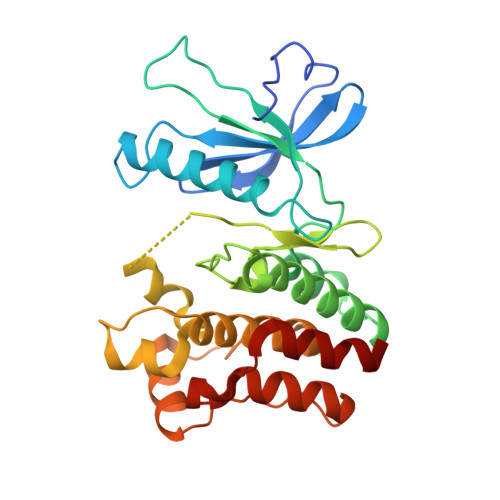Conformational switching of the pseudokinase domain promotes human MLKL tetramerization and cell death by necroptosis.
Petrie, E.J., Sandow, J.J., Jacobsen, A.V., Smith, B.J., Griffin, M.D.W., Lucet, I.S., Dai, W., Young, S.N., Tanzer, M.C., Wardak, A., Liang, L.Y., Cowan, A.D., Hildebrand, J.M., Kersten, W.J.A., Lessene, G., Silke, J., Czabotar, P.E., Webb, A.I., Murphy, J.M.(2018) Nat Commun 9: 2422-2422
- PubMed: 29930286
- DOI: https://doi.org/10.1038/s41467-018-04714-7
- Primary Citation of Related Structures:
6BWK - PubMed Abstract:
Necroptotic cell death is mediated by the most terminal known effector of the pathway, MLKL. Precisely how phosphorylation of the MLKL pseudokinase domain activation loop by the upstream kinase, RIPK3, induces unmasking of the N-terminal executioner four-helix bundle (4HB) domain of MLKL, higher-order assemblies, and permeabilization of plasma membranes remains poorly understood. Here, we reveal the existence of a basal monomeric MLKL conformer present in human cells prior to exposure to a necroptotic stimulus. Following activation, toggling within the MLKL pseudokinase domain promotes 4HB domain disengagement from the pseudokinase domain αC helix and pseudocatalytic loop, to enable formation of a necroptosis-inducing tetramer. In contrast to mouse MLKL, substitution of RIPK3 substrate sites in the human MLKL pseudokinase domain completely abrogated necroptotic signaling. Therefore, while the pseudokinase domains of mouse and human MLKL function as molecular switches to control MLKL activation, the underlying mechanism differs between species.
Organizational Affiliation:
The Walter & Eliza Hall Institute of Medical Research, Parkville, VIC, Australia. petrie.e@wehi.edu.au.















